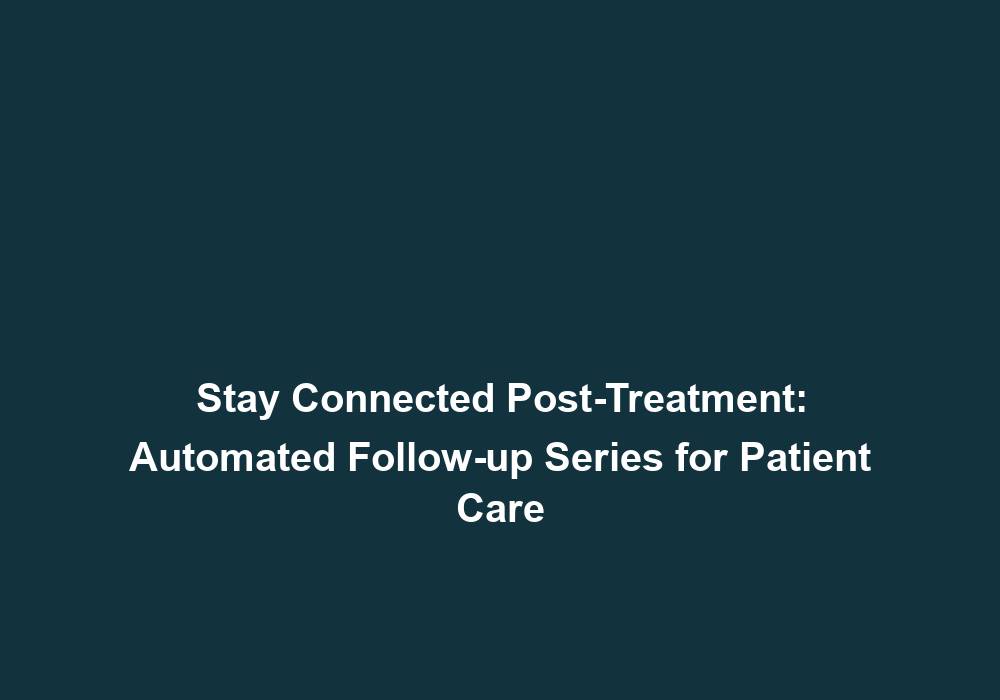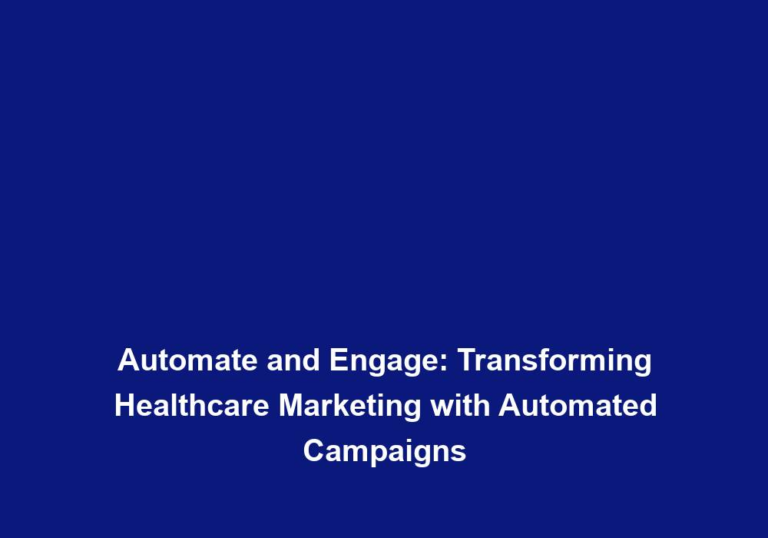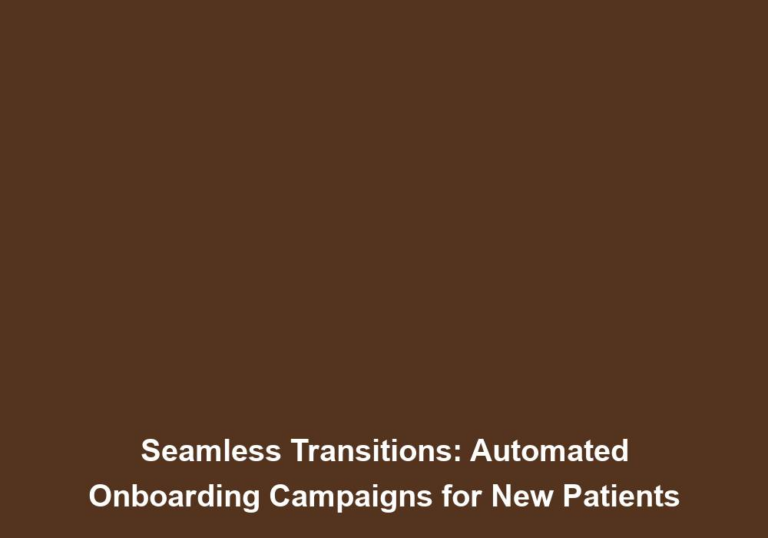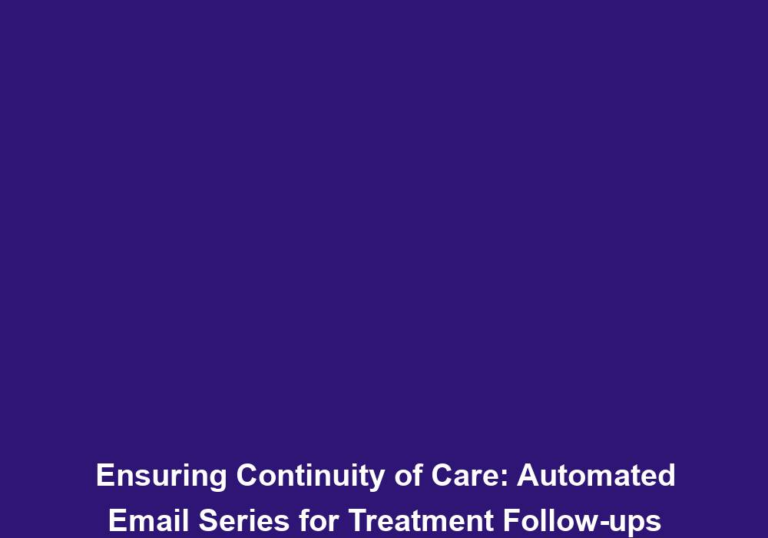Stay Connected Post-Treatment: Automated Follow-up Series for Patient Care
In today’s fast-paced world, staying connected with patients after their treatment is crucial for ensuring their well-being and maintaining a strong doctor-patient relationship. With advancements in technology, it has become easier than ever to automate follow-up series for patient care, allowing healthcare providers to stay connected with their patients efficiently and effectively. This article will explore the benefits of automated follow-up series and provide insights into how healthcare providers can leverage this technology to enhance patient care.
The Importance of Post-Treatment Follow-up
Post-treatment follow-up plays a vital role in patient care, as it allows healthcare providers to monitor their patients’ progress, address any concerns or complications that may arise, and provide ongoing support. By staying connected with patients after their treatment, healthcare providers can ensure a smooth recovery process and minimize the risk of any potential complications going unnoticed.
Staying connected with patients after their treatment is crucial for ensuring their well-being and maintaining a strong doctor-patient relationship. Post-treatment follow-up plays a vital role in patient care by allowing healthcare providers to monitor the progress of their patients. It provides an opportunity to address any concerns or complications that may arise and offer ongoing support. Regular follow-up appointments can help ensure a smooth recovery process and minimize the risk of any potential complications going unnoticed. By actively engaging with patients post-treatment, healthcare providers can enhance patient satisfaction and contribute to better overall outcomes.
The Challenges of Traditional Follow-up Methods
Traditionally, follow-up appointments were scheduled manually, often requiring patients to visit the healthcare facility for routine check-ups. While this approach has been effective to some extent, it can be time-consuming for both patients and healthcare providers. Additionally, it may not always be feasible for patients to travel long distances for routine check-ups, especially for those residing in remote areas.
Traditional follow-up methods, such as manual appointment scheduling and in-person visits, can be time-consuming and inconvenient for both healthcare providers and patients. Patients often have to take time off work or make arrangements for transportation, leading to potential disruptions in their daily lives. Moreover, for patients residing in remote areas, traveling long distances for routine check-ups can be challenging and costly. These challenges can result in missed appointments and delayed follow-up, potentially compromising the quality of patient care.
The Advantages of Automated Follow-up Series
Automated follow-up series offer numerous advantages over traditional follow-up methods. By leveraging technology, healthcare providers can streamline the follow-up process, save time and resources, and enhance patient satisfaction. Let’s delve into some of the key benefits of automated follow-up series:
1. Improved Efficiency
Automated follow-up series eliminate the need for manual appointment scheduling and reminders, freeing up valuable time for healthcare providers. By automating routine follow-up appointments, healthcare providers can focus on more critical tasks, such as diagnosing and treating patients. Additionally, patients can benefit from reduced wait times and greater convenience, as they can access follow-up care from the comforts of their own homes.
Automated follow-up series significantly improve the efficiency of the follow-up process for both healthcare providers and patients. By eliminating the need for manual appointment scheduling and reminders, healthcare providers can save valuable time and allocate their resources more effectively. This allows them to focus on essential tasks, such as diagnosing and treating patients, ultimately improving overall patient care. Patients, on the other hand, experience reduced wait times and greater convenience, as they can receive follow-up care from the comforts of their own homes. This not only saves them time and effort but also enhances their overall satisfaction with the healthcare experience.
2. Enhanced Patient Engagement
Regular communication with patients is vital for building trust and maintaining a strong doctor-patient relationship. Automated follow-up series enable healthcare providers to engage with patients consistently, providing them with the necessary information, guidance, and support. Through personalized messages and reminders, healthcare providers can ensure that patients stay informed, adhere to post-treatment instructions, and feel supported throughout their recovery journey.
Automated follow-up series play a crucial role in enhancing patient engagement. By consistently communicating with patients through personalized messages and reminders, healthcare providers can establish a strong connection and foster trust. This regular engagement ensures that patients receive the necessary information, guidance, and support they need to navigate their recovery journey successfully. By staying informed and adhering to post-treatment instructions, patients can actively participate in their own care, leading to better outcomes and increased satisfaction.
3. Timely Intervention and Monitoring
Automated follow-up series allow healthcare providers to monitor patients’ progress and identify potential complications promptly. By leveraging technology, healthcare providers can send automated surveys, questionnaires, or symptom checklists to patients, enabling them to report any issues or concerns they may be experiencing. This real-time data allows healthcare providers to intervene promptly, address any complications, and make necessary adjustments to the treatment plan, ultimately improving patient outcomes.
One of the significant advantages of automated follow-up series is the ability to monitor patients’ progress and identify potential complications in a timely manner. By utilizing technology, healthcare providers can send automated surveys, questionnaires, or symptom checklists to patients, empowering them to report any issues or concerns they may be experiencing. This real-time data provides healthcare providers with valuable insights into the patient’s condition, allowing them to intervene promptly and address any complications that may arise. By making necessary adjustments to the treatment plan based on this information, healthcare providers can optimize patient outcomes and prevent potential adverse events.
4. Cost and Time Savings
Automating follow-up series can significantly reduce costs associated with traditional follow-up methods. By minimizing the need for in-person visits, healthcare providers can save on administrative costs, overhead expenses, and resources. Patients can also save time and money by avoiding unnecessary travel and reducing their overall healthcare expenses. This cost-effective approach benefits both healthcare providers and patients, ensuring that resources are utilized efficiently.
Implementing automated follow-up series can lead to substantial cost and time savings for healthcare providers and patients alike. By reducing the need for in-person visits, healthcare providers can save on administrative costs, such as staffing and facility expenses. Additionally, the time and effort saved by patients who no longer have to travel for routine check-ups result in reduced healthcare expenses. This cost-effective approach benefits both parties involved, allowing resources to be allocated more efficiently and ensuring that patients receive the care they need without unnecessary financial burden.
Implementing an Automated Follow-up Series
To implement an effective automated follow-up series, healthcare providers must consider certain key factors. Here are some essential steps to guide the implementation process:
- Identify Follow-up Milestones: Determine the key milestones and timeframes for post-treatment follow-up based on the specific medical procedure or condition. This will help in structuring the automated follow-up series effectively and ensuring that patients receive timely and relevant information.
Identifying follow-up milestones is a crucial step in implementing an automated follow-up series. By determining the key milestones and timeframes for post-treatment follow-up, healthcare providers can design a structured and comprehensive automated series. This ensures that patients receive timely and relevant information at each stage of their recovery journey, optimizing the effectiveness of the follow-up process.
- Choose an Automated Follow-up Platform: Select a reliable automated follow-up platform that suits your practice’s needs and offers customizable features. Look for platforms that allow you to personalize messages, track patient responses, and integrate with your existing electronic health record (EHR) system for seamless data management.
Choosing the right automated follow-up platform is essential for the successful implementation of an automated follow-up series. Healthcare providers should select a reliable platform that aligns with their practice’s specific needs and requirements. Look for platforms that offer customizable features, allowing you to personalize messages and tailor them to the specific needs of your patients. It is also crucial to choose a platform that integrates seamlessly with your existing electronic health record (EHR) system, ensuring efficient data management and streamlined workflows.
- Craft Engaging Content: Develop informative and engaging content for the automated follow-up series. Tailor the messages to address patients’ specific needs and concerns at each follow-up milestone. Consider including educational materials, instructional videos, and relevant resources to enhance patient engagement and understanding.
Creating informative and engaging content is key to the success of an automated follow-up series. Healthcare providers should develop messages that are tailored to address patients’ specific needs and concerns at each follow-up milestone. Consider incorporating educational materials, instructional videos, and relevant resources to enhance patient engagement and understanding. By providing valuable and educational content, healthcare providers can empower patients to take an active role in their recovery process and ensure that they have the necessary information to make informed decisions about their health.
- Test and Optimize: Before launching the automated follow-up series, thoroughly test the system to ensure its functionality and usability. Collect feedback from a select group of patients to identify any areas for improvement. Continuously monitor and optimize the series based on patient responses and outcomes.
Thoroughly testing the automated follow-up series before its launch is crucial to ensure its functionality and usability. Healthcare providers should rigorously test the system to identify any potential issues or areas for improvement. Collecting feedback from a select group of patients can provide valuable insights into the user experience and help identify any areas that may require optimization. Continuously monitoring the series based on patient responses and outcomes allows healthcare providers to refine and enhance the follow-up process, ensuring that it remains effective and aligned with patients’ needs.
- Evaluate Outcomes: Regularly evaluate the outcomes and effectiveness of the automated follow-up series. Analyze patient engagement rates, response data, and overall patient satisfaction to identify areas of success and areas that may require further refinement. Incorporate patient feedback into the series to continuously enhance patient care.
Regularly evaluating the outcomes and effectiveness of the automated follow-up series is essential for continuous improvement. Healthcare providers should analyze patient engagement rates, response data, and overall patient satisfaction to gain insights into the success and areas that may require further refinement. Incorporating patient feedback into the automated follow-up series allows healthcare providers to continuously enhance patient care and ensure that the follow-up process remains relevant and beneficial.
Conclusion
Automated follow-up series offer healthcare providers a powerful tool to stay connected with their patients post-treatment. By leveraging technology, healthcare providers can enhance patient care, improve efficiency, and strengthen the doctor-patient relationship. The benefits of automated follow-up series include improved efficiency, enhanced patient engagement, timely intervention and monitoring, and cost and time savings. By implementing an automated follow-up series, healthcare providers can ensure that patients receive the ongoing support they need, leading to better patient outcomes and overall satisfaction.







